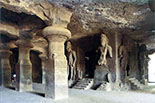|
HINDU CAVE TEMPLES at
|

|
HINDU CAVE TEMPLES at
|

The great cave temple in Elephanta Island, devoted to Shiva, was excavated in the 6th to the 8th centuries. To visit, one takes a ferryboat for one hour from the Gateway of India in Mumbai (a chance to enjoy good scenery), and then from the landing place, one goes up long flight of steps through forest for half an hour. The name of the island was originally Gharapuri Island, which was derived from the ancient name, Agrahara-puri. There are many artistic panels of sculpture carved on rock face in this cave, quite impressive and admirable in spite of there being some considerable damage. |
|
When looking on the splendid sculptures on the walls of this Hindu cave temple in the small island, the perimeter of which is only 7km, one might feel a admiration for the fact that they were carved more than 1,000 years ago. However, because there remain few epigraphs, it is difficult to determine the precise age of its excavation. It is likely that the cave on Elephanta Island was excavated under the dynasties of Kalachuri in the north or Chalukya in the south, established after the decline of the Vakataka Dynasty in the 6th century that had ruled the whole of Deccan. However, since both of Kalachuri and Chalukya Dynasties built temples from the 6th to the 8th centuries, there is no established theory whether this cave was excavated in the 6th, 7th, or 8th century.

Mumbai (former Bombay) had been in the hands of Portugal as a special economic area since its cession from Gujarat Sultan in 1534. When some Portuguese visited this island, they found a gigantic stone sculpture of an elephant and named this island Elephanta Island. The British colonists that came here next disassembled the sculpture to bring to Britain by sea in 1864, but the plan was abandoned on arrival in Bombay. The damaged sculpture has been set in the garden of Dr. Bhau Daji Lad Museum (formerly the Victoria and Albert Museum) in the Victoria Gardens in Mumbai since 1912. There are seven cave temples in Elephanta Island. The oldest two are located on the east side of the island, which is the upper place of a village called Mora near a Buddhist ruins called the ‘Hill of Stupa.’ One of them is unfinished. Severe demolitions by Portuguese and others sadly tarnished their previous brilliance. Cave 1, the largest and main cave, a Shiva Temple, is also unfinished; there are no stone carvings outside the façade composed of pillars. Though it used to be surrounded with wooden buildings, they do not remain. The inside of the cave is quite cool and is a refuge from rain and heat.

The Shiva temple is a hypostyle hall of about 28m square, having a main entrance in the north, and two other entrances in the east and west, each confronting a small courtyard. There is another cave facing each courtyard, called the East Shrine and the West Shrine. In the main hall stand more than 30 pillars, each of which is crowned with a cushion-type capital with fluting, having a round shape for the upper part and square shape for the lower part. Recently, original damaged pillars were replaced with pillars made of concrete.

When advancing strait from the north entrance, one can see the great sculpture of the main God Shiva at the far end. It gives an impression of the existence of the central axis from the north to south, but there is an independent sanctuary, which enshrines a Linga as a symbol of Shiva, lying to the east on the east-west axis. These two axes, crossing each other, make a cruciform plan, which is quite different from other cave temples in India.
Another cave that has a similar character is Cave 29 at Ellora. Both of them generat a pluralistic and bewildering space, in contrast to Buddhist cave temples whose space-composition is usually monistic.

The eastern courtyard is an artificial one excavated from a rock mountain. The East Shrine facing this courtyard is well proportioned despite being on a small scale. On the other hand, the shrine facing the western courtyard is tiny, and has a small pond nearby.
The main hall has a ceiling height of about 6m. Sculpted panels in almost all the walls are the most interesting cultural heritage in Elephanta. The south wall is divided into three parts, among which the central part was carved as a colossal image of triple-headed Shiva (Trimurti); the face looking east displays the character of the frightful god of destruction, Bhairava, the face looking west of a graceful woman showing delight and beauty, goddess consort Uma, and the central well-proportioned meditative face expresses harmony.

The number of the wall panels sculpted in relief is 15 altogether in the main hall. They depict various kinds of mythical scenes derived from ancient Indian epics. One panel portrays Shiva as an Ardhanari (hermaphrodite), female on the left side of the body and male on the right side, and another panel narrates the marriage scene of Shiva and Parvaty at Mount Kailasa. This marriage scene suffered much injury, but one can see lovely Parvaty, dressed up with jewels, and attended by other gods. Her father, Himavat (God Himalaya) places her hand in Shiva’s right hand, entrusting his daughter’s future. God Brahma presides over the ceremony, Vishnu accompanies as a helper, and Mainaka holds a vessel filled with celestial water symbolizing virginity. In two panels in the Gupta style, Shiva takes on the form of a Maha-Yogi or an ascetic performing Yoga, and Nataraja, the Lord of the Dance.

(In "UNESCO World Heritage" vol. 5. 1997, Kodan-sha ) |